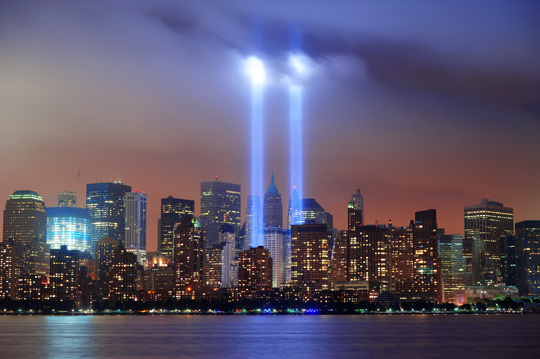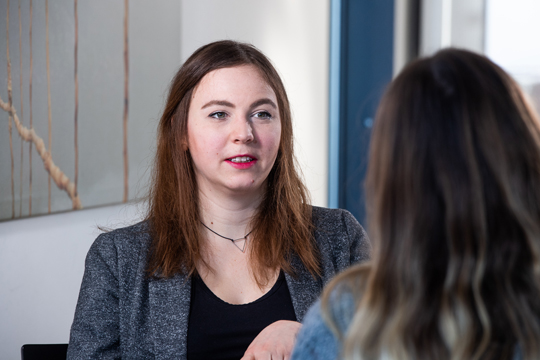Controlled Explosion or Aliens?
Freiburg, Sep 07, 2020
Nineteen years ago terrorists seized four aircraft in the United States and carried out the worst attacks ever experienced there. Almost 3,000 people died that day, and the world followed events live on TV. Even today the attacks give rise to many conspiracy theories. Deborah Wolf, a PhD student in the ‘Factual and Fictional Narration’ Graduate School at the University of Freiburg, is studying these conspiracy theories for her dissertation. Interviewed by Lara Wehler she talks about different theoretical approaches and how platforms like YouTube support the spread of conspiracies.

Columns of light commemorate the victims of the terrorist attacks on the World Trade Center in New York. Photo: rabbit75_fot/stock.adobe.com
Ms Wolf, what conspiracy theories are there about 9/11?
Deborah Wolf: The best-known conspiracy theories claim that the American government carried out the attacks in order to create a reason for the Iraq war and monitoring of the population. Another theory says that the American government knew about the attacks and didn’t prevent them. Some aspects are raised by conspiracy theorists particularly frequently: for example that the World Trade Center collapsed as a result of a controlled explosion. The theories differ widely, and there are far more abstruse ones. Some claim that aliens were responsible for the attacks, that for their experiments they abducted people from the Twin Towers and then caused them to collapse.
So what is a conspiracy theory in scientific terms?
There are various definitions of the term. One approach is to combine certain features: a group pursuing a secret plan to harm the population. These supposed intrigues are uncovered by the conspiracy theorists. Another option is to determine the theories by inference, that is discursively. This sort of approach always takes a contrary position to the mainstream and generally assumes a conspiracy from the start. Evidence for the official version is either disputed or said to be fake. Some theorists develop an alternative narrative while others simply bring the official into question. Conspiracy theories are organic and often relate to one another.
What makes presenting such theories as videos special?
A video is naturally a newer technical development and typical of contemporary conspiracy theories. Many amateurs can create and distribute videos themselves. What is special about this is that it combines visual and audio elements. Videos about conspiracy theories work with components from documentary films to appear more credible. This includes for example the voiceover, pictures highlighting something, diagrams, tables and figures. These components are put together in such a way that they overload the viewer.
Overload how?
Fast cutting, combinations of images, music, voiceover: they’re all stress stimuli. Then usually the image stops after this overloading. Things go black and a calm voice conveys the message. This combination aims to make the viewer more receptive to the argument, because, unlike documentary films, these videos only want to convey an argument. So they often use ‘affective moments’.

Some claim that aliens were responsible for the attacks on 9/11, says Deborah Wolf, who is studying conspiracy theories for her dissertation. Photo: Klaus Polkowski
What influence does the Internet and especially platforms such as YouTube have on the spread of conspiracy theories?
Conspiracy theories have been around for a long time, they aren’t an Internet phenomenon. However science is undecided whether they are an anthropological constant or a phenomenon of the Enlightenment. Conspiracy theories were always spread via the media. With the Internet, the entrance threshold is even lower, so the theories were increasingly visible. Platforms like YouTube in particular ensure their spread. Scientists have proven this in a quantitative study.
How exactly did they do this?
YouTube’s algorithms sort results by their own criteria. The platform identifies this as relevance. These aspects include, for example, how the videos are received. But the algorithm is so complex that we could not reproduce the criteria. Conspiracy theory videos are suggested to users particularly frequently. This may be because these videos have a strong reception, for instance discussions in the comments. Researchers also found that there is a ‘click hole effect’. That is, if you watch a conspiracy theory video, then YouTube’s autoplay function suggests more of such videos and the suggestions get more and more extreme.
What conclusion do you draw from this?
My theory is that YouTube is above all a medium for generating reach and recruiting people to conspiracy theories. Other platforms network the theorists and so contribute to the development of a community. The influence of the Internet on 9/11 theories also relates to the fact that the event happened along with the emergence of the Internet. Understanding of the attacks partly took place on the Internet.
So why are there so many different conspiracy theories about 9/11?
The 11th September was a media event. That is, an event the media not only reported, but also took part in. The event and the media influenced each other. This is ideal for conspiracy theories that basically mistrust the media. They respond to individual and collective fears. If someone doesn’t understand the world because it is too complex or too contradictory, conspiracy theories offer a convincing explanation. The 9/11 theories also fit with the fact that the US government’s intelligence work was not optimal and there was a lot of uncertainty afterwards.
Video: Deborah Wolf talks about conspiracy theories and the corona virus

